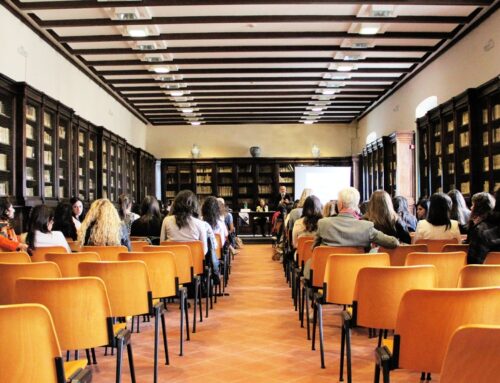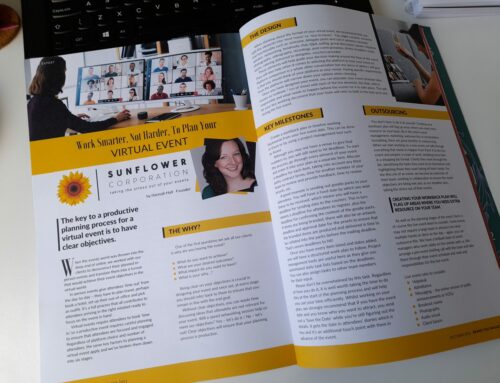Running annual events can be an exhilarating experience, but it also comes with its fair share of challenges. Whether you’re organising a roadshow, a conference or a business meeting, the key to long-term success lies in embracing the concept of continuous improvement. By constantly striving to enhance the event, you can attract a larger audience, retain previous attendees, foster participant satisfaction, and ensure the growth and sustainability of any annual gathering, virtual or in-person.
We encourage our clients to look at the cycle of annual events, and not just see the live event as one piece of the journey. In this blog post, we’ll explore the importance of continuous improvement and share practical tips to help you elevate your event year after year.
Reflect on past events:
Before embarking on the journey of improving an annual event, it’s crucial to reflect on previous occasions. Evaluate what went well, what could have been better, and areas that require immediate attention. Gather feedback from clients, participants, sponsors – and don’t forget to ask volunteers if you have any – to gain insights into their experiences. This evaluation will serve as a foundation for future improvements.
What we do! Sunflower’s RRR (Review, Reflect, Refine) process ensures that we de-brief with clients after every event, collect feedback from clients and attendees, and check in with suppliers; this information feeds into the first meeting about next year’s event. We also do this together within our team and keep a running document for future use.
Set clear goals:
Work with your clients to define their vision and set clear goals for their annual event. Identify specific areas that they want to enhance year-on-year, such as participant engagement, product launches, use of new technology or entertainment options. Having well-defined goals will guide their decision-making process and enable you to measure the success of your improvements accurately.
Example: working on the annual game quality conference Qualicon, we run a content committee that collectively decides on the theme, speakers and agenda for the event as well as addressing their objectives, ensuring they link back to their company mission.
Embrace technology:
The world of event technology is fast-paced, and there’s always improved or new technology to enhance the experience of both organisers and participants. Leverage event management software to streamline registration processes, facilitate communication, and manage data efficiently. Embrace social media platforms and mobile applications to engage with your audience, provide real-time updates, and encourage interaction among participants.
Example: we started collaborating with suppliers in Airtable on one annual event, and have increased the scope of how we work with it each year, from speaker admissions to agenda management
Continuous participant feedback:
Engage with event participants regularly (or encourage your client to do so), even after the event has concluded. Collect feedback through surveys, online forums or social media; if feedback is in a public arena, such as social media, always acknowledge it and respond.
An ongoing dialogue will help you gauge customer satisfaction, identify issues and discover areas for improvement. Actively incorporating feedback into future plans demonstrates your commitment to delivering the best possible experience.
Example: we send our clients a survey after each event, asking them to feed back on the sessions, from unavoidable ‘on-the-day’ problems to bigger issue that can be addressed and rectified before the next event. Another client runs a Discord channel for continuous communication and member events throughout the year between conferences.
Building relationships:
With any event, there are relationships that need to be managed and nurtured. These could be with sponsors, partners, volunteers or the media.
Regularly communicate with all relevant parties to understand their expectations and explore ways to align their objectives with your event’s goals. Where possible, involve them in the decision-making process, as it can lead to a more rewarding experience for all participants.
Example: for annual events, we book in a regular meeting with the client; these can be monthly or fortnightly at first, moving to weekly as the event nears. This way, we can keep an eye on deadlines and budgets, and any changes are dealt with immediately. For in-person events, site visits are also extremely valuable as well as supplier meetings and pre-con briefing calls. .
Regular evaluation and documentation:
Continuously evaluate the impact of your improvements against the goals you set. Document your findings and learnings from each event, including successful strategies and areas that require further attention. This documentation will serve as a valuable resource when planning future events, helping you avoid repeating past mistakes and building upon previous successes.
Example: We keep concise meeting notes with action points that are shared with everyone soon after the meeting; the first point of every meeting agenda is to make sure that all previous actions have been addressed.
Save the date!
Last, but not least, secure and promote the date for future events as early as possible – for in-person events, start looking for next year’s venue even before this year’s has happened, or if your client is planning to use the same venue again, start negotiations and leverage the current event as much as possible to secure the best possible price for your client.
Example: for the Qualicon virtual conference, the final slide of the two-day event has the dates for the following year’s event, and the relevant website and social media pages are updated the same day.
Running annual events is an exciting and dynamic process that thrives on continuous improvement. By reflecting on past events, setting clear goals, embracing technology, building relationships and conducting regular evaluations, you can ensure that your event grows and evolves each year.



